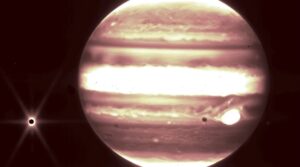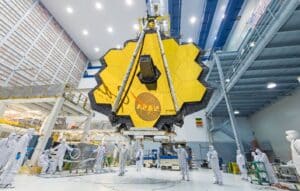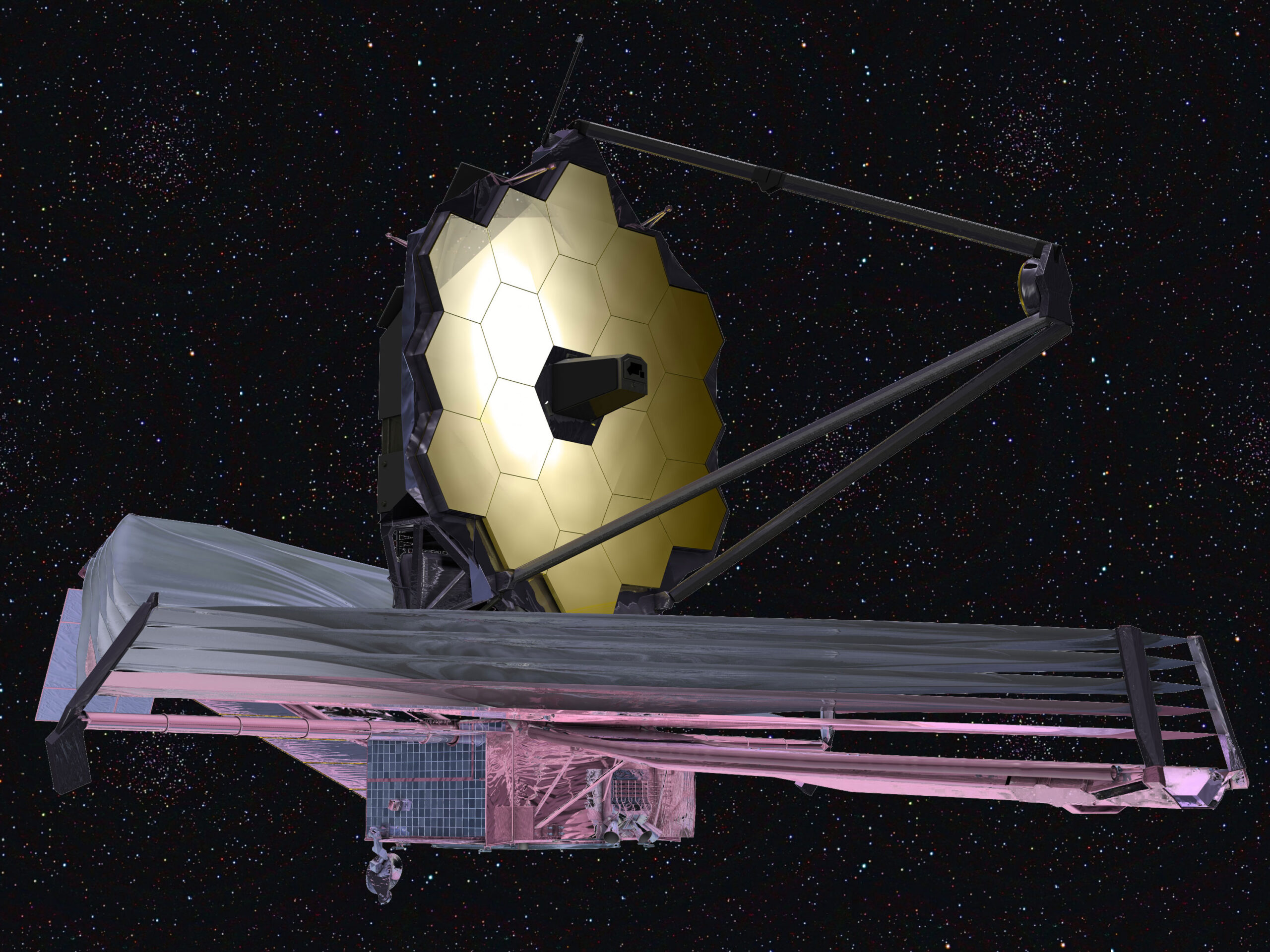James Webb Space Telescope, an infrared space observatory, was carried by Arianespace’s Ariane 5 rocket into orbit on December 25, 2021, at 7:20 a.m. EST (12:20 GMT; 9:20 a.m. local time in Kourou).
On July 12, NASA made the first scientific photos from Webb available in a live event. In our recently released article, we go into further depth about the first photographs and what they signify for JWST science.
NASA’s largest and most potent space scientific observatory, the $10 billion James Webb Space Telescope, will explore the cosmos to learn more about the evolution of the universe from the Big Bang to the birth of extraterrestrial planets and beyond. It is one of NASA’s Great Observatories, a collection of enormous space telescopes that can look far into space, like the Hubble Space Telescope.
The James Webb Space Telescope traveled over a million miles (1.5 million kilometers) to a Lagrange point, a gravitationally stable place in space, over the course of 30 days. On January 24, 2022, the telescope reached L2, the second sun-Earth Lagrange point. This orbit will enable the telescope to remain in line with Earth as it orbits the sun since L2 is a location in space close to Earth that is opposite from the sun. Other space telescopes like the Herschel Space Telescope and the Planck Space Observatory have found it to be a useful location.
James Webb Space Telescope’s mission
NASA, the European Space Agency, and the Canadian Space Agency got together and made a team of scientists and engineers to work on the £8.4bn telescope. They worked on it for 20 years.
The Webb was sent into space on Christmas Day, December 25, 2021. It took about a month to get to its destination in solar orbit, which is about a million miles from Earth. Once the telescope was in place, it took months to set up all of its parts, such as a sun shield the size of a tennis court, align its mirrors, and calibrate its instruments.
Since the universe has been growing for 13.8 billion years, the light from the first stars and galaxies has been “stretched” from shorter wavelengths that we can see to longer wavelengths that we can only see in the infrared.
This is what lets Webb see details about the universe that have never been seen before. These are the first of millions of pictures that the new telescope will take over the next 20 years.

Each high-resolution, full-color picture that was shown on Tuesday (July 19) took weeks to make from raw data from a telescope. People in the US, Canada, Israel, the UK, and Europe, among other places, got together to watch the movie when it came out.
Millions of galaxies
James Webb Telescope looked into the vast space and found a galaxy that is 13.5 billion years old. Researchers think this is the oldest galaxy ever found. Last week, the powerful telescope started being used for science.
The spinning group of stars, gas, and dust held together by gravity happened 300 million years after the Big Bang. This galaxy is 100 million years older than the previous record-holder, GN-Z1, which was the most distant and oldest galaxy ever found. Hubble Space Telescope found GN-Z1 in 2016. It took 13.4 billion years for the galaxy’s light to reach Hubble.
In two preprints that came out Wednesday, scientists from the Harvard and Smithsonian Center for Astrophysics talked about the new record-setting galaxy, called GLASS-z13. The scientists also found a galaxy called GLASS-z11 that is about the same age and also beat all the records that had been set before.
Rohan Naidu, one of the researchers who found GLASS-z13 in Webb’s data, told New Scientist, “We found two very good candidates for very far away galaxies.” “If these galaxies are as far away as we think they are, the universe is only a few hundred million years old at that point.”
Researchers told New Scientist that the two galaxies are smaller than our own Milky Way galaxy, which has a diameter of 100,000 light-years. GLASS-z11 is about 2,300 light-years wide, and GLASS-z13 is about 1,600 light-years wide.
Images of Jupiter and its moon
Recently James Webb Space telescope images of Jupiter show a lot of detail. They show the giant planet’s famous Great Red Spot, its cloud bands, and even some of its faint rings. In the pictures, you can also see a few moons, like Europa, an icy moon that hides a huge ocean beneath its icy shell.
Stefanie Milam, a Webb Associate Planetary Science Project Scientist at NASA’s Goddard Space Flight Center in Greenbelt, Maryland, said in the same statement, “I couldn’t believe how clear and bright everything was.” “It’s really cool to think about the fact that we can look at these kinds of things in our solar system.”
Scientists were especially excited to see the James Webb telescope images of Jupiter because they show that the James Webb can see satellites and rings near bright solar system objects like Jupiter, Saturn, and Mars. Scientists will use Webb to find out if we can see the plumes of moons like Europa and Saturn’s moon Enceladus that stick out into space.
Webb might be able to see these things on the surface of Europa. Milam said, “I think it will be one of the best things we can do with this telescope in the solar system.”
The James Webb Space Telescope was made to track things moving as fast as Mars, which can go 30 milliarcseconds per second at its fastest. During the telescope’s start-up, the team looked at several asteroids, which all looked like dots because they were so small.
The team showed that the telescope can still get useful data from all of its scientific instruments for objects moving up to 67 milliarcseconds per second, which is more than twice the expected baseline. This is like taking a picture of a turtle crawling while standing still.

James Webb Space Telescope Key Facts
Launch date: Dec. 25, 2021.
Cost (at time of launch): $10 billion.
Orbit: JWST will orbit the sun, around the second Lagrange point (L2), nearly 1 million miles (1.5 million kilometers) from Earth.
Primary mirror size: 21.3 feet (6.5 meters) across.
Sunshield: 69.5 ft by 46.5 ft (22 meters x 12 meters).
Mass: 14,300 lbs (6,500 kg).
Findings in the James Webb Telescope data
Like its predecessor, the Hubble Space Telescope, the potent James Webb Space Telescope is anticipated to take incredible pictures of cosmic objects. The Hubble Space Telescope is still functioning well, which is fantastic news for astronomers, and it’s likely that the two telescopes will collaborate throughout JWST’s initial years of operation. In addition, JWST will examine exoplanets discovered by the Kepler space telescope or continue real-time observations made by ground-based space telescopes.
NASA, the European Space Agency (ESA), and the Canadian Space Agency worked together admirably to create the James Webb Space Telescope. Over 300 institutions, organizations, and businesses from 29 U.S. states and 14 other nations participated in the JWST, according to NASA. The James Webb Space Telescope is expected to operate for five years, although the ultimate target is ten years.
Researchers are already smashing records with their findings in the James Webb Space Telescope data. For instance, two galaxies that have recently been discovered may be the furthest objects ever seen. We are viewing galaxies as they were 300–400 million years after the Big Bang, if the analysis is accurate.
James Webb Telescope First Images
The newly operational telescope produced views of brilliant nebulae, dancing galaxies, and the furthest star systems with never-before-seen detail in the first full-color James Webb Space Telescope images released on Tuesday.
Both scientists and the general public were in awe.
Astronomer Jacob Bean, who studies exoplanets at the University of Chicago, admitted in an interview with The Independent that “my reaction was very much not professional.” “Just blown away and overwhelmed by the amazing detail you observed in these photographs at this degree of detail.”
But the photographs were intended to convey more than just the magnificent.
The five photographs that were released on Tuesday were very fast exposures intended to demonstrate what Webb is capable of, but they nonetheless offered scientifically valuable data that piqued the interest of the astronomy community for more thorough studies. Dr. Bean is already salivating at the knowledge contained in a spectrum of light from the exoplanet Wasp-96b’s atmosphere in anticipation of what Webb would do for his field of study.
It's here–the deepest, sharpest infrared view of the universe to date: Webb's First Deep Field.
Previewed by @POTUS on July 11, it shows galaxies once invisible to us. The full set of @NASAWebb's first full-color images & data will be revealed July 12: https://t.co/63zxpNDi4I pic.twitter.com/zAr7YoFZ8C
— NASA (@NASA) July 11, 2022
Without a space telescope with the size of Webb, whose primary mirror is 6.5 meters in diameter as opposed to the Hubble Space Telescope’s 2.4 meters, the Webb deep field image would not have been conceivable.
The image was made using 12.5 hours of exposures that Webb took while pointing its giant mirror towards a little area of darkness that was roughly the size of a sand grain held at arm’s length. Numerous dazzling gem-like galaxies can be seen in the resulting image, some of which are 13.1 billion light years away and, given that a light year is the distance light travels in a year, 13 billion years old.
Where is James Webb Telescope Available
With NASA’s Where is Webb website, you can monitor Webb and see what stage of deployment it is currently in.
What’s Next for James Webb Telescope?
What will the James Webb Space Telescope do now that its first jaw-dropping photographs have been revealed? More observations from the expedition are expected this week, including the first pictures of Jupiter, which are coming on Thursday, according to scientists (July 14).
The telescope is now working on both its first-year programs and early science suite. The telescope is outperforming the predictions researchers used to design this year’s work, so scientists are already looking ahead to the observatory’s second year, which starts next summer.
Reionization and the first light
This is the period of time immediately following the Big Bang, when the universe as we know it today first began. Light was not visible until the cosmos cooled down sufficiently for these particles to start merging in the early moments following the Big Bang, when it was composed of a sea of elementary particles (such electrons, protons, and neutrons). The “epoch of reionization,” which refers to the time when neutral hydrogen was reionized (made to have an electric charge again) by radiation from these earliest stars, is another topic that JWST will investigate.

Assembly of galaxies
In order to understand how matter is arranged on enormous scales, which in turn provides us with clues as to how the universe developed, it is necessary to look at galaxies. One of James Webb Space Telescope objectives is to look back at the oldest galaxies to better understand how the spiral and elliptical galaxies we see now developed from various shapes over billions of years. Additionally, researchers are attempting to understand how galaxies currently originate and come together, as well as how we came to have such a diverse collection of observable galaxies.
Birth of stars and protoplanetary systems
The hawk One of the most well-known areas where stars are born is in a nebula’s “Pillars of Creation.” Stars form in gas clouds, and as they get bigger, their radiation pressure drives the gas away that was surrounding them. However, looking into the gas is challenging. James Webb Telescope’s infrared eyes will be able to observe heat sources, such as stars developing in these star-forming cocoons.
Planets and origins of life
Numerous exoplanets have been found in the previous ten years, including ones using NASA’s planet-hunting Kepler Space Telescope. JWST’s potent sensors will be able to take a closer look at these planets, possibly even imaging their atmospheres in certain cases. Scientists may be better able to anticipate whether or not a particular planet is habitable if they have a better understanding of the atmospheres and conditions under which planets arise.
Four scientific instruments on board the JWST will allow for observations in the visible, near-infrared, and mid-infrared (0.6 to 28.5 micrometers) spectrums.
Apart from this, if you are interested, you can also read Entertainment, Numerology, Tech, and Health-related articles here: Alexis Clark Net Worth, Black Panther 2, Marvel Echo Release Date, Frozen Fruit Recipes, Black Tourmaline, Webtoon XYZ, Fastest VPN for Android, IFVOD, XXXX Dry Review, Highest Grossing Indian Movies of all Time, Highest Grossing Movies of All Time, Rush Limbaugh net worth, Gotham Season 7, Parag Agrawal Net Worth, Tara Reid Net Worth, Blonde Trailer, Fastest VPN for PC, WPC18, Highest Paid CEO in India 2022, Highest paid athletes 2022, My5 TV Activate, Kissmanga, WPC16, Highest Paid CEO 2022, Grey’s Anatomy Season 19, WPC15, Alexa.com Alternatives,
The Resident Season 6, Kraven The Hunter, One Punch Man season 3, The Resident Season 5, Yellowstone season 5, Ozark season 4 part 2, How to Remove Bookmarks on Mac, Outer Banks Season 4, How to block a website on Chrome, How to watch NFL games for free, DesireMovies, How to watch NFL games without cable, How to unlock iPhone, How to cancel ESPN+, How to turn on Bluetooth on Windows 10, Outer Banks Season 3,
6streams, 4Anime, Moviesflix, 123MKV, MasterAnime, Buffstreams, GoMovies, VIPLeague, How to Play Music in Discord, Vampires Diaries Season 9, Homeland Season 9, Brent Rivera Net Worth, PDFDrive, SmallPDF, Knightfall Season 3, Crackstream, Kung Fu Panda 4, 1616 Angel Number, 333 Angel Number,
666 Angel Number, 777 Angel Number, 444 angel number, Bruno Mars net worth, KissAnime, Jim Carrey net worth, Bollyshare, Afdah, Prabhas Wife Name, Project Free TV, Kissasian, Mangago, Kickassanime, Moviezwap, Jio Rockers, Dramacool, M4uHD, Hip Dips, M4ufree, Fiverr English Test Answers, NBAstreamsXYZ, Highest Paid CEO, The 100 season 8, and F95Zone.
Thanks for reading. Stay tuned with us.









































